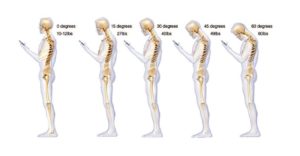Answer: Quicker than anyone realized.
Researchers out of Korea performed a study to see what 20 minutes of gaming on a smartphone did to your neck muscles, upper back muscles, and posture. So they had 18 men sit upright in an unsupported chair, playing a game on their smartphone that was known to be an engaging game to play. The game is called Anipang, I’ve never heard of it, but apparently it’s the kind of game that really takes your mind off of where you are and what your body and posture is doing. The subjects sat in an unsupported chair at 90 degree angles between the thighs, legs, and back. They measured the posture with a digital camera and markers placed on them, and they measured muscle activity of the neck muscles and the trapezius muscle in the neck and in the upper back.
They did these tests in increments of 0 minute, 5 minutes, 10 minutes, and 15 minutes. However, they had to stop the study at 16 minutes because the subjects ran out of Cheetos. Just kidding, the truth of the matter was they were experiencing excruciating pain. Actually, they did have pain. At the beginning of the study, the average pain experience was 0/10. No pain. At the end of the study, only 16 minutes into game play, they had an average neck pain of 4.2/10, and an average upper back pain of 2.2/10.
What about posture? Their heads practically fell off.
The rate of neck flexion increase was very sharp among subjects as they played the smartphone game, and a significant increase of neck flexion began as early as 5 minutes after the start of smartphone use.
and,
…the timing of substantial neck flexion increase in this experiment occurred much earlier than in the findings of Lee, Park, and Yoo. In most cases of people typing on desktop and laptop computers, the computers are placed on a standard desk and the arms of users are supported on the desk for typing.
People tend to use their phones and iPads unsupported. Or, they have to position themselves into an awkward position to use them. When using your phone, your shoulders slump. Your neck flexes. Your head extends.
 But that’s not all. Bad posture equals increased muscle activity, and tragically, muscles in the upper back that have given up. Your neck gets really tight, and the bones in your upper back start to sit on the ligaments for passive support. You’re not even trying to use your muscles at this point. Your discs and ligaments are taking up the stress of posture. In this study, the muscle activity of the subject’s neck immediately shot up, while the muscle activity of the thoracic (upper back) paraspinal muscles immediately shut off. Along with that, the lower trapezius, responsible for shoulder posture and stability shuts off–getting worse over time.
But that’s not all. Bad posture equals increased muscle activity, and tragically, muscles in the upper back that have given up. Your neck gets really tight, and the bones in your upper back start to sit on the ligaments for passive support. You’re not even trying to use your muscles at this point. Your discs and ligaments are taking up the stress of posture. In this study, the muscle activity of the subject’s neck immediately shot up, while the muscle activity of the thoracic (upper back) paraspinal muscles immediately shut off. Along with that, the lower trapezius, responsible for shoulder posture and stability shuts off–getting worse over time.
When your muscles shut off and you are resting on your ligaments and discs, this is known as a flexion relaxation response. This is the theory behind low back pain and degenerative arthritis with constant bad posture.
So with smartphone use, as you develop “text neck,” and you slouch your real body while you play in a virtual world, you almost certainly will start having neck pain in the short term, and will eventually develop arthritis and low back pain in the long term.
This is a study that is relevant to the patients that we see in our chiropractic office in downtown San Francisco. We see a lot of tech workers who are stuck behind a desk, or a laptop, or a smartphone just to get work done. Our patients tend to be younger workers who haven’t had the time to develop arthritis. Because of this, we see a lot of neck pain cases. The first step in taking care of your neck pain is to develop an awareness of your posture at work and at play. If you are spending 16 minutes at a time on your smartphone without support, then you will statistically develop moderation neck pain, and you will have tight neck muscles. The question is, will you pull yourself away and do something about it, or will you grow complacent and let it go?
Dr. Todd Lloyd



